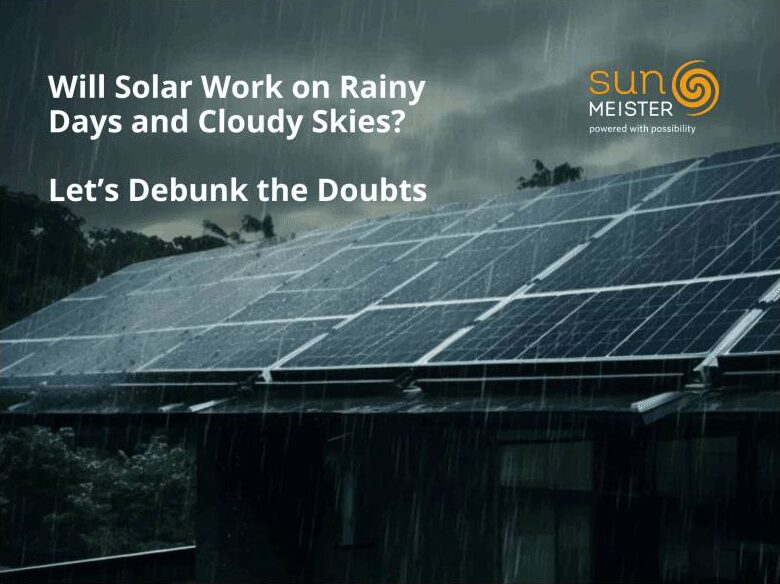When people think of solar power, they picture sun-drenched rooftops and cloudless skies. So naturally, many Indian homeowners wonder: Will my solar panels work during the monsoon or on overcast days? The answer is a reassuring yes, but with some nuances. Let’s bust the myths, explore the tech, and show how Sunmeister’s smart hybrid solar systems continue to deliver power, rain or shine.
Myth #1: Solar Panels Don’t Work on Cloudy Days
Reality: Solar panels work as long as there is daylight—even when skies are grey. Yes, solar output drops during cloudy weather, but not as dramatically as you might think. On a heavily overcast day, panels can still produce 10–25% of their normal output depending on cloud density, angle of sunlight, and system configuration. In India’s monsoon season, this means a noticeable dip—but certainly not a shutdown.
Tip: The better the panel and inverter technology, the more efficient your system remains during low-light conditions.
Partial Shading? Not a Deal Breaker
Urban homes often deal with trees, neighbouring buildings, or water tanks that cast shadows. This partial shading can reduce panel output—unless your system is smart enough to handle it.
Sunmeister uses Victron MPPT (Maximum Power Point Tracking) charge controllers, which are purpose-built to optimise energy capture—even in non-ideal conditions.
What MPPT Controllers Do:
Track the ideal voltage/current ratio for your panels in real time
Extract more power under variable or low-light conditions
Prevent “shading losses” from disproportionately affecting system performance
So, even when part of your roof is shaded by a mango tree at 3 PM, your system still works efficiently.
Learn more about Victron MPPT tech here: Sunmeister Victron Products
How Hybrid Systems Adapt in Bad Weather
Unlike basic solar setups, hybrid systems combine solar panels, inverters, batteries, and grid integration. This means you’re not dependent on the sun alone.
During Monsoons:
On sunny days: Your panels charge your battery and power your home.
On cloudy days: The battery provides backup.
On multiple rainy days: The system automatically draws from the grid only when needed.
Sunmeister’s systems use Victron MultiPlus and Quattro inverter/chargers, which switch seamlessly between solar, battery, and grid—ensuring uninterrupted power. With optional battery storage, you don’t just survive monsoon blackouts—you stay productive through them.
Real-World Data: How Much Energy During Rainy Days?
According to energy data across Indian metros:
Cities like Mumbai, Chennai, and Kolkata receive 4.2–5.0 kWh/m²/day even during monsoon months.
Panels in these conditions can still generate 20–40% of their rated capacity depending on system quality and orientation.
Smart systems don’t just survive monsoon—they adapt.
Sunmeister’s Smart Monitoring Tools
Sunmeister offers real-time energy monitoring through Victron’s Cerbo GX and GX Touch displays, linked to the Victron Remote Monitoring (VRM) Portal. This allows homeowners to:
Track solar generation—even during cloud cover
Monitor battery health and consumption trends
Set alerts for low battery or grid fallback events
This kind of transparency builds trust in your system—and helps you manage your energy smarter.
Why Weather-Resilient Solar Matters
Grid outages during storms are common across India—especially in Tier 2/3 cities.
Diesel gensets are noisy, polluting, and increasingly expensive.
Solar + battery systems offer not just savings, but peace of mind.
Your panels may rest during a thunderstorm, but your home won’t skip a beat.
Final Verdict: Yes, Solar Works in Monsoons
Sunmeister’s hybrid solar solutions, powered by Victron’s globally trusted components, are engineered for India’s dynamic weather. Whether you live in sunny Gujarat or rainy Kerala, your solar investment stays productive.
So the next time clouds roll in, don’t worry—your Sunmeister system’s got it covered.
Explore our Victron-powered solar systems: https://sunmeister.in/victron-products
Reference Links
1. Solar panels work on cloudy days (10–25% output)
https://www.energy.gov/energysaver/solar-panels-cloudy-days
2. India’s solar potential during monsoons – 4.2–5.0 kWh/m²/day https://mnre.gov.in/img/documents/uploads/file_f-1661510574987.pdf (See solar radiation maps & seasonal output potential)
3. Effectiveness of MPPT controllers under shading
https://www.victronenergy.com/solar-charge-controllers/mppt-150-70-tr https://www.solarreviews.com/blog/what-is-an-mppt-charge-controller
4. Victron inverter/charger products used by Sunmeister
https://sunmeister.in/victron-products (Official Victron product page via Sunmeister)
5. Victron Remote Monitoring (VRM) platform – Cerbo GX
https://www.victronenergy.com/panel-systems-remote-monitoring/cerbo-gx https://www.victronenergy.com/live/vrm_portal:start
6. Battery performance in hybrid solar systems
7. Diesel generator costs and pollution in India

